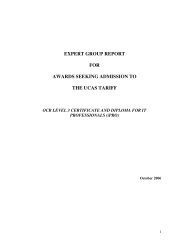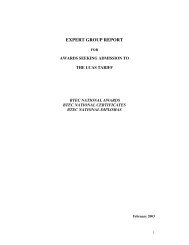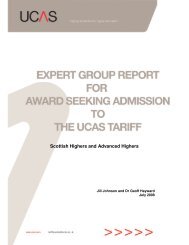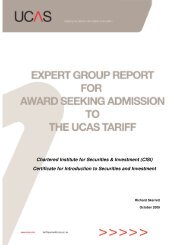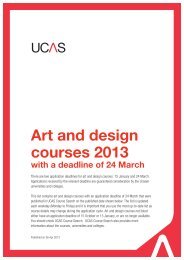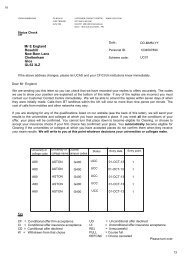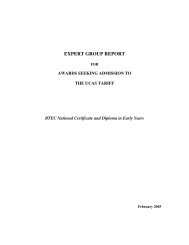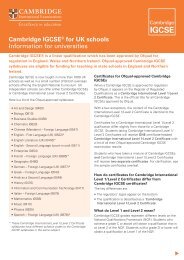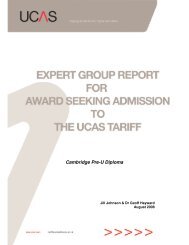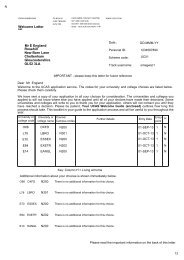International qualifications 2013 (pdf) - CUKAS
International qualifications 2013 (pdf) - CUKAS
International qualifications 2013 (pdf) - CUKAS
Create successful ePaper yourself
Turn your PDF publications into a flip-book with our unique Google optimized e-Paper software.
Qualifications currently offered<br />
Public and private institutions of higher education (university and<br />
non-university) accept the Apolytirion as a minimum entry<br />
requirement. As the medium of instruction is English in all private<br />
HEIs, candidates have to provide poof of their proficiency in<br />
English. Private HEIs have their own English placement test, and<br />
if judged necessary, students have to follow an English foundation<br />
programme.<br />
Turkish-Cypriot System<br />
Access to the higher education universities and institutions of<br />
Cyprus and Turkey is through a competitive central entrance<br />
examination. Students who have successfully completed high<br />
school and gained the Lise Diplomasi need to take the University<br />
Entrance Examination to gain entry to universities. This exam is<br />
organised by Higher Board of Education (YOK). Local universities<br />
also accept students without the YOK Entrance Exam (OSS) on<br />
condition that they pass an entrance exam administered by the<br />
institutions themselves. In most universities in Turkey, and in all<br />
universities in Cyprus, the medium of instruction is English.<br />
Therefore, students are obliged to provide proof of at least<br />
intermediate level of English (TOEFL or IELTS) or to pass the<br />
institution’s own English proficiency test. Students who are<br />
unsuccessful will study a year’s English foundation programme,<br />
which has an ongoing assessment process in addition to a final<br />
proficiency test at the end of the academic year.<br />
Czech Republic<br />
EVALUATION<br />
Maturitní Zkou˘ska/Maturita Vysvědčení o Maturitní Zkou˘sce<br />
(Maturita from vocational/technical schools)<br />
Acceptable as a group qualification satisfying general<br />
entrance requirements.<br />
GRADING SYSTEM<br />
1 vyborny (excellent)<br />
2 chvalitebny (very good)<br />
3 dobry (good)<br />
4 dostatecny (pass)<br />
5 nedostatecny (fail)<br />
EDUCATION SYSTEM<br />
Elementary school has two levels: the first stage now covers the<br />
first to fifth grade, and the second stage the sixth to ninth grade.<br />
Nine years of elementary education are followed by four years of<br />
secondary education. Successful completion of compulsory<br />
school and meeting the entrance requirements (usually including<br />
entrance examination) are prerequisites for admission to<br />
secondary schools.<br />
Secondary education is newly structured into three levels<br />
depending on the length of the programme:<br />
a<br />
b<br />
c<br />
Secondary education (1–2 years) (ISCED 2C).<br />
Secondary education completed by attaining an apprenticeship<br />
certificate (výuc˘ ní list) – two to three years or a shortened<br />
study programme for those having completed secondary<br />
education with school-leaving certificate (ISCED 3C).<br />
Secondary education completed by a school-leaving<br />
examination (maturitní zkous˘ ka) – study programmes of<br />
various length, eg after completing a four-year study (ISCED<br />
3A) or, for those with an apprenticeship certificate, a twoyear<br />
follow-up course (ISCED 4A).<br />
According to the Education Act (of 24 September 2004), the<br />
results of the education of a pupil included in a school report is<br />
expressed by a classifying grade, verbally or by a combination<br />
of both. The head teacher shall decide upon the manner of<br />
evaluation with the consent of the School Board. This concerns<br />
both elementary and secondary schools. There is no final<br />
examination at the end of elementary school, but in the last<br />
year of compulsory school attendance, each school issues to<br />
its pupils a final evaluation stating how the pupil concerned has<br />
achieved the educational goals stated by the law. Study at a<br />
secondary school leads to the traditional matriculation<br />
examination, Maturitní Zkouška or Maturita. The passing of the<br />
Maturitní Zkouška is a prerequisite for admission to a higher<br />
education institution (and also to a tertiary professional school).<br />
ACCESS TO HIGHER EDUCATION<br />
There are now 26 public institutions, two state institutions and<br />
46 private institutions of HE in the Czech Republic.<br />
By law, higher education institutions are of two types – university<br />
type, providing all levels of study programmes, and non-university<br />
type, usually offering only bachelor’s degree programmes. Due to<br />
the historical development, all existing higher education<br />
institutions established before the Education Act came into force<br />
are university type institutions. Recently established higher<br />
education institutions have been accredited as non-university<br />
types. This refers to all private institutions as well as to the first<br />
newly established public institution “College of Polytechnics”<br />
(Vysoká s˘kola polytechnická). All accredited bachelor’s degree<br />
study programmes provide education of ISCED 5A Level,<br />
ie education that enables students to continue in follow-up<br />
master’s degree study programmes.<br />
The minimum requirement for admission to a higher education<br />
institution is secondary education completed by the maturitní<br />
zkous˘ka examination. The requirement for admission to a<br />
master’s programme is successful completion of a bachelor’s<br />
programme. The requirements for admission to a Doctoral<br />
programme are successful completion of a master’s programme.<br />
Students may apply for admission to several faculties. Each<br />
higher education institution decides on the number of admissions<br />
and on specific admission procedures (secondary school results,<br />
approval of credits from previous studies of other fields of study<br />
or of tertiary professional school, etc). The admission procedures<br />
usually include an entrance examination, in particular, a written<br />
test, an oral examination or both. If the number of applicants who<br />
meet the conditions is higher than the maximum number that can<br />
be enrolled, applicants are rank ordered based on the<br />
examination results.<br />
Denmark<br />
EVALUATION<br />
Folkeskolens 10 Klasseprøve (formerly Folkeskolens<br />
Afgangsprøve) (after Class 10)<br />
Acceptable in lieu of GCSE on a subject for subject basis (except<br />
English Language).<br />
Studentereksamen (STX)<br />
Hojere Forberedelseseksamen (HF)<br />
Hojere Handelseksamen (HHX)<br />
Hojere Teknisk Eksamen (HTX) and EUX<br />
Acceptable as group <strong>qualifications</strong> satisfying general entrance<br />
requirements.<br />
INTERNATIONAL QUALIFICATIONS 17



